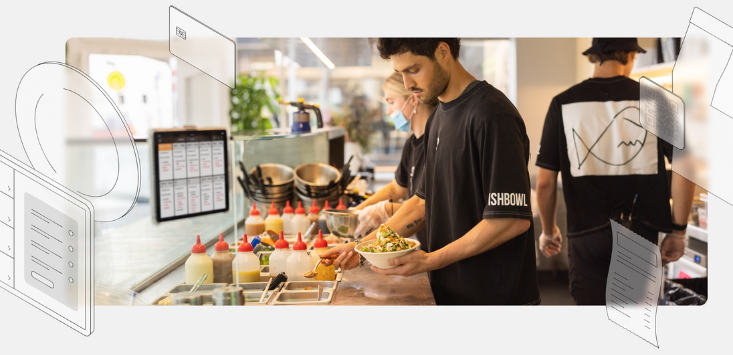
Source: Supplied.
It’s been a tough few years for the restaurant industry. Amid lockdowns, staffing shortages, and supply chain challenges, Australian businesses have proven their resilience and adaptability.
To see what lies ahead, digital payments platform Square partnered with YouGov Research to survey 500 restaurateurs and 1000 diners across Australia.
The resulting Future of Restaurants report points to a bright future for Australian restaurateurs, with 77% of those surveyed feeling optimistic about their restaurant’s ability to thrive over the next 12 months.
But the restaurant industry still faces major challenges: from understaffing to supply chain issues and grappling with new operating models. For many businesses, technology has been the key to surviving —and thriving —through the pandemic.
Here’s how leading businesses are using technology to tackle industry challenges head on.
Great staff become scarce
Finding great staff has never been easy. Add in international border restrictions and a shortage of skilled migrants, and suddenly everyone’s competing for the same talent.
In the Future of Restaurants report, 75% of restaurant businesses said they were faced with a staffing shortage, with 20% of all positions currently unfilled.
In 2022, it’s no longer enough to have an open role. Today’s jobseekers ask “Why should I want to work for you?”
The best restaurants are getting strategic when it comes to attracting —and more importantly, retaining —great people.
If you’re struggling to hire staff, consider the following tips:
- Review your benefits: are they appealing to jobseekers?
- Offer the right balance of culture, security and flexibility
Inevitably, every business will face staffing shortages. The good news is there’s technology to help. In fact, 97% of restaurateurs surveyed believe automation technology will help fill critical gaps in their business.
Technology can help you to:
- Streamline your rosters and stay on top of last-minute changes
- Empower staff efficiency with QR code ordering and tableside payments
“Leaning on technology in your restaurant takes courage,” acknowledges Michael Bascetta, CEO, Worksmith and Owner of Made Well Group. “We know that service is the number one priority, and adjusting your technology providers comes with a bit of risk in implementation, but the efficiency gains are huge.”
Looking to scale your business? Find out how Square’s solution can help
Thinking outside the box
During extended lockdowns, many restaurants pivoted to online ordering and delivery to keep the lights on operations moving forward.
Now, even with the return of in-person dining, restaurants are keeping these extra revenue streams. As many as 67% of full-service restaurants plan to continue offering food delivery in-house.
The pandemic forced businesses to explore new ways of generating income, and restaurateurs aren’t looking back. Many sell retail items alongside services like meal kits, bottled cocktails, and limited edition merch —and 37% of Australian consumers have bought these items in the past year.
Takeaway is here to stay
Customers got used to self-serve ordering during the pandemic, and many have realised they prefer the convenience of takeaway over in-person dining.
Over a third (35%) of Australian adults now prefer takeaway dining to eating in. And with 44% of restaurants introducing takeaway/delivery options for the first time during the pandemic, the trend is here to stay.
The good news? The control remains in restaurateurs hands, with almost half of the Australian consumers surveyed (45%) preferring food delivery via a restaurant’s own website or app, over providers like UberEats and Menulog.
A new way to pay
“Cash only” is a thing of the past for many restaurants, with Australian consumers adopting new payment technologies like tap-and-go, mobile transactions and even buy-now-pay-later (BNPL) payments.
45% of Australian adults say they prefer to pay via digital payments like contactless, pay-at-the-table or QR codes.
In response, 69% of restaurants now offer payment options via mobile wallet apps, and more than half (52%) offer contactless EFTPOS payments. As many as 22% of businesses offer BNPL options, as demand for the service grows.
“While BNPL for restaurant dining is still an emerging use case, we are seeing some of our restaurant partners report higher order values and an increase in return diners,” says Katrina Konstas VP for APAC Sales, Afterpay.
“BNPL has proven its value for retailers, and we believe it’s going to have a similar impact on the restaurant industry.”
Solving the supply chain challenge
A staggering 96% of businesses surveyed in Square’s report claimed to have experienced supply chain disruptions in the past 12 months.
The pandemic caused global supply chain issues that still continue, forcing restauraters to get creative when sourcing their produce.
Seven in ten restaurants (71%) have sourced or plan to source produce from local Australian suppliers, and 40% of these restaurants plan to grow their own produce in the next 6-12 months.
Technology is lending a helping hand. Businesses are using automation tools to help track menu item inventory and keep front-of-house and back-of-house systems in sync.
Through all the challenges of the last few years, one thing remains constant. Technology acts as an enabler and an amplifier, allowing restaurateurs to cut down on the admin and focus on the things they do best: providing great service and memorable dining experiences.
Read now: How Fishbowl and Square are changing Australian fast food together

Square creates tools that help sellers start, run and grow their businesses. Their free point of sale service offers tools from accepting card payments to invoicing, inventory, analytics and employee management.


COMMENTS
Reader comments have been turned off on this post.